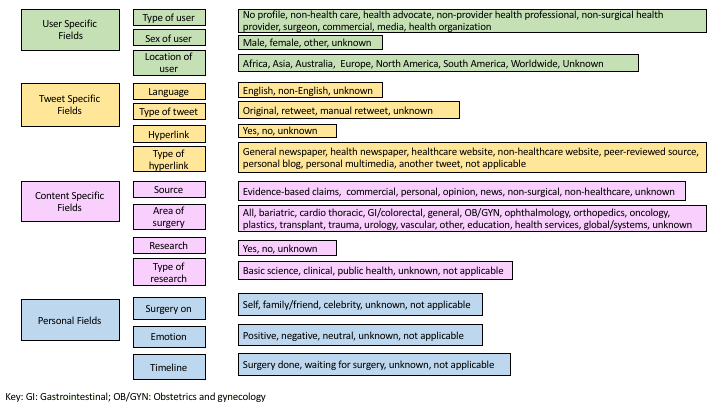N. NAGARAJAN1,2, H. Alshaikh1, A. Nastasi1, B. Smart3, Z. Berger6, E. B. Schneider4, M. Dredze5, J. K. Canner1, N. Ahuja1 6Johns Hopkins University School Of Medicine,General Internal Medicine,Baltimore, MD, USA 1Johns Hopkins University School Of Medicine,Surgery,Baltimore, MD, USA 2Brigham And Women’s Hospital,Boston, MA, USA 3University Of Southern California,Surgery,Los Angeles, CA, USA 4Brigham And Women’s Hospital,Center For Surgery And Public Health,Boston, MA, USA 5Johns Hopkins University,Computer Science,Baltimore, MD, USA
Introduction:
There is growing interest among various stakeholders in using social media sites to discuss healthcare issues. However, little is known about how social media sites are used to discuss surgical care. There is also a lack of understanding of the types of content generated and the quality of the information shared in social media platforms about surgical care issues. We therefore sought to identify and summarize conversations on surgical care in Twitter, a popular microblogging website.
Methods:
A comprehensive list of surgery-related hashtags was used to pull individual tweets from 3/27-4/27/2015. Four independent reviewers blindly analyzed 25 tweets to develop themes for extraction from a larger sample. The themes were broadly divided further to obtain data at the levels of the user, the tweet, the content of the tweet and personal information shared (Figure I). Standard descriptive statistical analysis and simple logistic regression analysis was used.
Results:
In total, 17,783 tweets were pulled and 1000 from 615 unique users were randomly selected for analysis. Most users were from North America (62.4%) and non-healthcare related individuals (31.8%). Healthcare organizations generated 12.4%, and surgeons 9.5%, of tweets. Overall, 67.4% were original tweets and 79.0% contained a hyperlink (11% to healthcare and 8.7% to peer-reviewed sources). The common areas of surgery discussed were global surgery/health systems (18.4%), followed by general surgery (15.6%). Among personal tweets (n=236), 31.1% concerned surgery on family/friends and 24.4% on the user; 61.1% discussed procedures already performed and 58.0% used positive language about their personal experience with surgical care.
Surgical news/opinion was present in 45% of tweets and 13.7% contained evidence-based information. Non-healthcare professionals were 53.5% (95% CI: 3.8%-77.5%, p=0.039) and 72.8% (95% CI: 21.1%-91.7%, p=0.017) less likely to generate a tweet that contained evidence-based information and to quote from a peer-reviewed journal, respectively, when compared to other users.
Conclusion:
Our study demonstrates that while healthcare professionals and organizations tend to share higher quality data on surgical care on social media, non-health care related individuals largely drive the conversation. Fewer than half of all surgery-related tweets included surgical news/opinion; only 14% included evidence-based information and just 9% linked to peer-reviewed sources. As social media outlets become important sources of actionable information, leaders in the surgical community should develop professional guidelines to maximize this versatile platform to disseminate accurate and high-quality content on surgical issues to a wide range of audiences.
